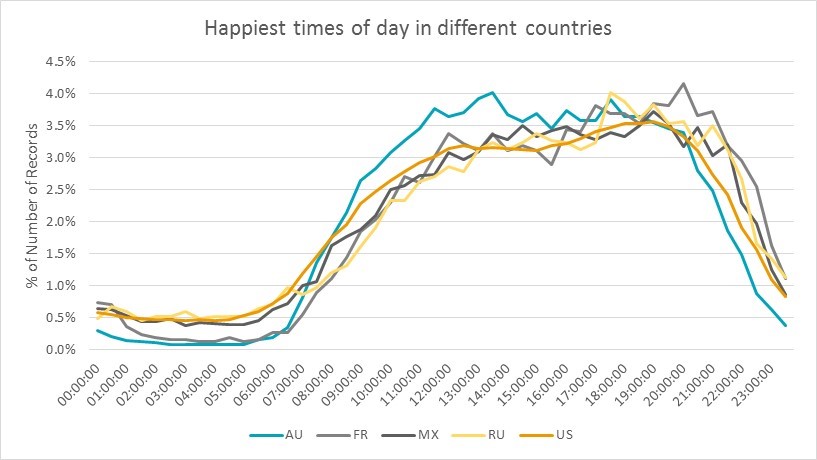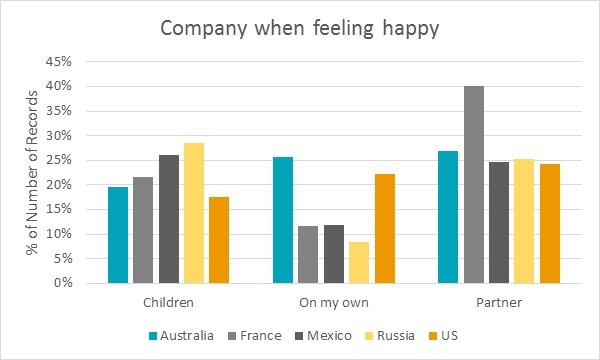With January blues finally setting in, consumer’s peak of happiness may be lower than usual, but that’s not to say it’s any less of a window of opportunity for advertisers. Emotions are one of the key drivers behind our purchasing decisions, and it’s believed that consumers in a good mood are more receptive to advertising than those feeling down. With this in mind, RealityMine has analysed the data of 4,647 panelist from five countries – the US, Australia, France, Mexico and Russia – in order to find their happiest time of day and the social setting around these happy moments.
The data was gathered using an eDiary, which captures panelists’ answers to various questions on a half hourly basis during seven days. Every half an hour panelists are asked how they are feeling. Panelist are then able to choose all the emotions, from a list of 24, which best describe their feelings on a given half hour. The figures below are based on the number of times emotions were reported by these panelists.
The happiest time of day
In the US and Mexico ‘happy’ is reported most at 7 PM when people are likely to have finished work and household chores and are ready to unwind. In France, the happiest time of day is a bit later at 8 PM whereas Russians are more likely to feel happy at 5:30 PM. In contrast to other countries that have their happy peaks in late afternoon or early evening, Australians have two main peaks – one after lunch time at 1:30 PM and another one after work at 5:30 PM.

Figure 1: Happiest times of day in Australia, France, Mexico, Russia and USA
The context of happy feelings
Although there is a clear difference in ‘happy’ peak times between Americans and Australians, these two countries are the most similar when it comes to the social setting around those happy feelings. As Figure 2 shows, in both countries, people are most commonly either on their own (22%-26%) or with a partner or spouse (24%-27%) when feeling happy.
‘Relaxing’ is reported by 16% of Americans and 14% Australians, and it’s clearly the most common activity among those who reported feeling happy.
In France, happiness is clearly experienced the most when with a partner or spouse (40%). When feeling happy, French panelists are most likely to be having a meal, drinking or talking on phone or in person. At least one of these activities are reported by 40% of French panelist during their happy moments.
Mexicans and Russians are also most likely to be in a company of a partner or spouse (25%) but even more likely to be with their children (26%-29%). When Mexicans report feeling happy, 33% of them are either socializing, having a meal or working. Russians’ favourite activity is socializing (14%), and they also feel happy when drinking, relaxing and doing child-adult activities.

Figure 2: Most common company reported in each country when feeling happy
Other positive emotions during the day
When we looked at other positive emotions experienced in different countries, we found again that Americans and Australians are most similar, with ‘happy’ as the most reported positive emotion throughout the day. In France, ‘happy’ is the dominating positive emotion except in the morning when ‘confident’ is more commonly reported.
We found that ‘amused’ is the most common positive emotion throughout the day in Mexico and Russia. And like French panelists, Mexicans feel confident in the morning while Russians feel significantly more confident than happy during the whole day.


